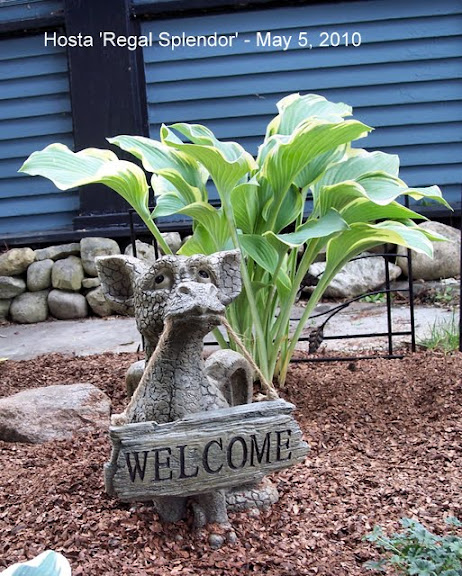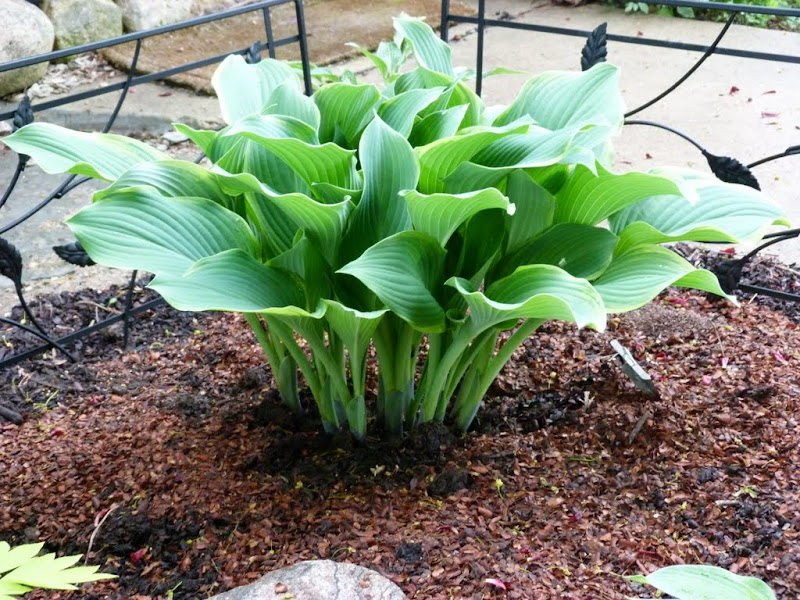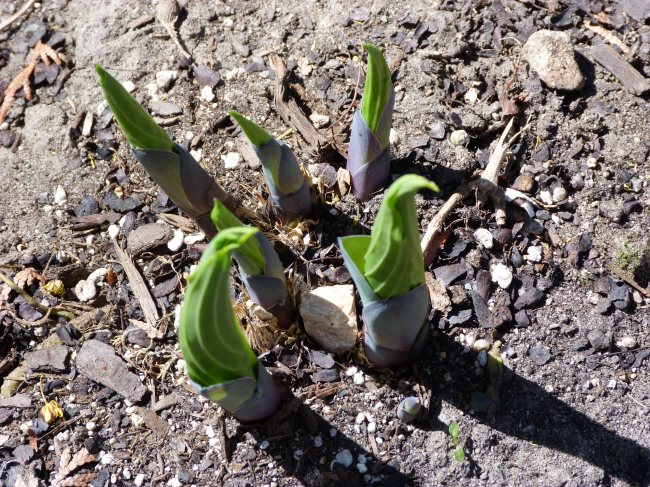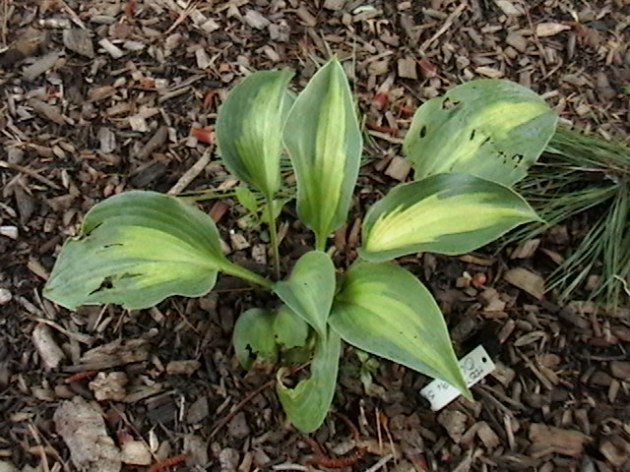Garden Appreciation Day!
I’ll bet most of you know how this works.
So often, when you go out into your garden, you see everything that needs to be done instead of everything you’ve accomplished. You spot the stray weeds while overlooking the beautiful foliage. You see the plant you really need to move rather than soaking in the beauty of your overall garden landscape. It’s easy to get caught up in our to-do lists, while overlooking our well-done lists.
Today, I was cleaning up sticks in my front garden in the wake of a crazy wind storm the previous evening. A lady came by walking her dachshund. She saw me cleaning up and commented, “You work so hard, and then nature undoes everything.” I said that the damage wasn’t just so bad, and that at least none of my plants seemed to have suffered more than a broken frond or two.
We got to talking a bit more and she said, “I’ve been walking by here for a few years now, and every time I see your yard I think to myself, ‘She’s really made this beautiful.'” I thanked her, and she went on to tell me that she waits for my garden to come up every spring so she can admire it.
Obviously, her comments made my day. I’m always looking at other gardens, which are many times better than my own, and admiring other people’s handiwork. My garden always seems to be lacking (and often severely) by comparison. Rarely do I take the time to appreciate what I’ve done, and all I’ve accomplished. All it took was one lady with a dachshund to remind me that I need to do that more often.
So, my gardening friends, appreciate your gardens! Let’s consider today Garden Appreciation Day. What do you appreciate about the gardens your hands have helped create?
Spring Flowering Perennials for Dry Shade
There are plenty of beautiful plants that will grow in average to moist shady areas, but dry shade can be tough. And finding a pretty flowering perennial that will tolerate dry shade is even tougher. The drought of 2012 here in the upper Midwest tested even the sturdiest plants, and this year I’ve learned which ones are the true survivors in my garden. The plants I’m listing below not only tackled the drought last year with barely any supplemental watering from me (thanks to city watering restrictions), but came back this year none the worse for wear. I heartily recommend them for your dry, shady spots.
Epimediums
These perennials can be difficult to come by, and occasionally expensive as a result, but it’s worth the effort to track them down. Not only will epimediums dazzle you with dainty, dangling, fairy-like flowers in early spring, but they’ll provide attractive foliage all season long, and most varieties put on a great show of fall color. The flowers of epimediums are generally small, and it can take a gardener’s eye to appreciate them because of the way they’re tucked into the plant’s foliage, but I love them because they’re not ostentatious and, when I go looking for them amidst the spring growth, they feel like my special little secret.
Hellebores
The first thing I do every spring, as the snow is finally melting, is to go out and look for the hellebores. These sturdy plants seem like they’ll survive anything, and they never fail to impress me by blooming earlier than even the crocuses and daffodils (hence the common name, Lenten rose). Hellebores are gaining in popularity, and there are some spectacular new colors and double-blooming varieties coming on the scene regularly. My own are of the plain, single variety–as sturdy as they come. But check out the image from my garden (below) and you’ll see that they’re really anything but plain. My hellebores always draw comments from people wondering what that pretty, early-blooming flower is.
Solomon’s Seal
Okay, I’m cheating a bit here–Solomon’s seal isn’t what you’d call a “flowering perennial.” Although it does have a bloom, it’s more of a little white teardrop that’s barely noticeable. Still, it has spectacular foliage, a graceful habit, and it tolerates dry shade like nothing else. In late April or so, you’ll begin to see the pips of each individual frond poke out of the soil. Over time, Solomon’s seal will spread to blanket a shady area. (It’s not the least bit aggressive, though. In fact, I wish it would spread a little faster.) I wouldn’t garden in the shade without it.
Trilliums
This little woodland flower is an ephemeral, meaning that it shows up in the spring and disappears with the heat of summer. But, while they last, trilliums put on a lovely show. Like Solomon’s seal, they’ll spread slowly in woodland soil to form a nice patch of flowering spring beauty. (Fun fact: Trillium seeds are spread by ants.) In some states, trilliums (a native wildflower) are protected. In any case, picking them or harvesting them from the wild is damaging. When you pick a trillium, which removes the leaves from the stem, you’re taking away the plant’s ability to produce food to sustain its continued growth. When you harvest them, you diminish the already small population of wild plants. So, leave them alone and get them from a grower who does not harvest wild plants.
Gardening in dry shade does sometimes mean that you have to dial down your expectations when it comes to showy blooms and learn to appreciate the subtle beauty of woodland species and ephemerals. I’m a big believer in any plant that can tolerate shady, dry conditions, and return again with enthusiasm the following spring. Take some time to track down these shade-loving beauties–you won’t be disappointed!
FINDING PERENNIALS: If you’re looking for some difficult-to-find perennials, Dave’s Garden has a great resource. Search the PlantFiles database for the plant in question (example: epimedium) and click on individual varieties that interest you. Not only can you read more about the specific plant, and usually see photos, but the site will often list vendors who have the plant available. (Clicking on “Learn more about” beneath any specific vendor name will take you to the Garden Watchdog page, which will provide vendor information and reviews.)
It’s Spring! Don’t Step on the Hostas
Every spring, I look forward to getting out into the garden to look for signs of my hostas (and other plants) emerging. I’m giddy this time of year as everything comes to life after a long, cold, dark winter. And that’s probably why I reacted badly when my daughter, who happened to be looking out the window to see if my son and his girlfriend had come back from their walk, commented, “Those doofuses just ran right through your garden.”
I fumed and muttered that my son should know better. Walking in the garden has always been taboo around here, and there are some good reasons why.
Take a look at the photo above. That’s an emerging hosta in my garden. The little pointy things are what many hosta people refer to as pips. Each pip is made up of several tightly-wrapped sets of leaves that will unfurl as the season progresses. In my photo, the pips are well above ground and fairly easy to avoid. Early on, though, the pips can be right at the soil line or still hidden under mulch.
The problem with walking in the hosta garden is that accidentally stepping on an emerging hosta can have negative consequences, especially if perfect leaves are your goal. (And really, why wouldn’t they be? Hostas are all about leaves.) Bending or crushing the pip often tears the emerging leaves before they even unfurl, leaving them looking tattered.
The photo above shows leaf damage to a hosta that’s been accidentally stepped on while emerging.
It’s frustrating to see hostas that you’ve been waiting for all season unfurl with damaged leaves. Lots of other things, from slugs to hail to foliar nematodes, can cause damage to hosta leaves, but stepped-on damage is easily preventable–just don’t stomp around in your hosta garden (or at least step very carefully), and try to keep others out of it.
I did let my son and his girlfriend get away with their trespassing mostly unscathed. The only consequences they suffered were the Mom Look of Death ™ and a boring lecture on the anatomy of a hosta pip. Hopefully they understand now why stepping in my garden is verboten.
Best Hostas to Grow: Part 1 – The Classics
Let me preface something: for a hosta collector, picking the “best hostas” is like picking your favorite child–impossible. And yet, here I am trying to do the impossible and provide lists of some can’t-miss hostas that every garden with at least part shade needs. For part one of this article series, I’m focusing on a few classic varieties that have been gracing hosta gardens for a decade or more and have established themselves as winners.
My list is by no means the definitive list and, of course, it’s all subjective. But I’ve based my picks on hostas that I grow myself, as well as recommendations from many a hosta grower. If you want to know what the majority of hosta lovers view as some of the best around, the American Hosta Society publishes an annual list of the most popular hostas based on member votes. Some of my picks match those on the current AHS list of favorites. (You’ll note that the AHS vote always tends to swing toward the flashy variegated hostas we all love, but there are some great solid-colored classics, too.) All of these, in my opinion, are garden rock stars.
Five Great Classic Hostas
H. ‘June’
Try this. Seriously. Walk up to any hosta grower and ask them to name some of their favorite hostas off the top of their head. I’d be surprised if ‘June’ didn’t make every single list. This hosta is a medium-sized sport of another fantastic hosta, ‘Halcyon.’ Its leaves have great substance, which means they’re slug-resistant–always a plus! ‘June’ can look very different depending on how much sun or heat it gets. In shade, ‘June’ is a variegated kaleidoscope of chartreuse and blue tones. Grown in more sun, it will lighten up to shades of green and pale yellow to near-white. Whatever its appearance, every shade garden needs ‘June.’
H. ‘Regal Splendor’
I bought ‘Regal Splendor’ three years ago when I saw it sitting on a clearance shelf at a local nursery. It wasn’t overly impressive when I first planted it, but most hostas take two or three seasons (or more for the bigger varieties) to really start showing off. The following season, ‘Regal Splendor’ doubled its size, and then I was impressed. The season after that, it doubled its (already doubled) size yet again, and I was blown away. This large vase-shaped steely-blue-green beauty with yellow edge variegation and slightly wavy leaves won me over in a big way. Make sure to give this large hosta plenty of room to spread out.

Here’s H. ‘Regal Splendor’ the year I planted it.

And here’s ‘Regal Splendor’ emerging in the spring one year later, and double its size.
H. ‘Halcyon’
As I mentioned above, ‘Halcyon’ is the parent plant that produced ‘June,’ its popular offshoot (or sport.) But ‘Halcyon’ stands on its own merit as a beautiful medium-sized blue hosta with great form and substance. Every hosta garden needs attractive, solid-colored plants to serve as a calming backdrop, and ‘Halcyon’ fills that role perfectly.

H. ‘Halcyon’ has great form and substance. Give it a good bit of shade to help maintain its pretty blue color.
H. ‘Sagae’
This hosta tops the 2011 American Hosta Society popularity poll for a reason. I won a giant division at a local hosta society auction a few years ago, and it’s been the standout in my garden that everybody comments on. ‘Sagae’ is a very large hosta, and anyone purchasing a young plant should understand that it’s going to take some time for this beauty to reach maturity.
Hosta ‘Sagae’ in my garden as a newly-planted auction win. Most large hostas will take several years to reach this size, but they’re worth the wait.
H. ‘Sum and Substance’
The name of this variety says it all, doesn’t it? ‘Sum and Substance’ is another big boy–in the Very Large category, like ‘Sagae.’ And like other giant hostas, it takes some time to come to size, but when it does it’s definitely got a wow factor with its gigantic chartreuse leaves. This variety is fairly sun tolerant (given enough moisture), and the color will brighten up the more light you give it.

‘Sum and Substance’ is a big guy!
It’s a Start!
As I was creating this list of classics, it occurred to me just how enormous the task of recommending some great hostas is. This list is only the beginning, but I think it’s a great start. Not only would any of these hostas make a great addition to your shade garden, but most, if not all, of these gorgeous varieties should be readily available in local nurseries. (Just avoid purchasing them from big box stores like Walmart, Home Depot, Lowes and Menards. More on that in a future article.)
Are there any classic hostas (introduced a decade or more ago) that you’d like to recommend? Post them in the comments. And stay tuned for more lists of must-have hostas in future articles!
Perennial Gardening on a Budget
I used to spend lots of money at nurseries every gardening season. Let’s face it–a good nursery brings any gardener joy. To a  gardener, strolling through a selection of perennials, gleefully picking out new additions, is akin to a shopoholic hitting Chicago’s Magnificent Mile or perhaps even Rodeo Drive. But the problem is: shopping on the Magnificent Mile or Rodeo Drive isn’t cheap. Sure, you’ll find swanky designer fashions, but you’ll pay the price, too. And you’re likely to come home with a lot less swag than if you’d hit up the local outlet mall, instead.
gardener, strolling through a selection of perennials, gleefully picking out new additions, is akin to a shopoholic hitting Chicago’s Magnificent Mile or perhaps even Rodeo Drive. But the problem is: shopping on the Magnificent Mile or Rodeo Drive isn’t cheap. Sure, you’ll find swanky designer fashions, but you’ll pay the price, too. And you’re likely to come home with a lot less swag than if you’d hit up the local outlet mall, instead.
Regardless, I love a good nursery, and I have to make annual pilgrimages to my favorites every spring just because. But I spend a whole lot less at the nurseries now than I used to, because I’ve discovered how to get designer plants at outlet mall prices. Here are my best tips.
Craigslist Is Your Friend
I love Craigslist. Sure, there’s a seedier side to the free-for-all classifieds site, but most of the spamming, scamming and other unseemly stuff that you need to be savvy about isn’t happening in the “farm+garden” section. Simply hitting up Craigslist and searching using terms like “perennials” (or a specific plant, such as “hostas” or “daylilies”) will almost always yield some great results throughout the growing season, and particularly in the spring and, to a lesser degree, the fall when gardeners are busy dividing overgrown plants. Since most gardeners sell their divisions for under $5 (unless they’re very large or rare divisions) and most nurseries sell their stock for at least double, and often triple, that (at least here where I live), the savings is pretty obvious.
And here’s another great tip for Android and iPhone users–download the Craigslist app! All you need do once you have the app installed is add your location (usually an area surrounding a major city) and your individual search terms and the Craigslist app will deliver notifications to your phone as they’re posted. You can even email advertisers through the app. It’s my favorite tool and, best of all, it’s free!
Freecycle Is Your Friend, Too
If cheap plants don’t do it for you, how about free ones? Freecycle is a great place to search for plants (and a lot more) that people no longer want and hope to give away to someone who can use them…at no charge. Perennials don’t show up on Freecycle as often as they do on Craigslist, but every now and then you’ll find someone clearing out a yard full of lilies or hostas or other perennials who just wants to find her plants new, loving homes. If you haven’t subscribed to your local Freecycle, it’s definitely worth looking into. You never know when someone’s going to be giving away something you need (from little things to major appliances–no, I’m not kidding) and you also never know when you’ll need to get rid of something that someone else might want. Most of the perennials on Freecycle will be pretty ordinary varieties, but occasionally you find some real winners. (And did I mention they’re free?)
Here’s a quick etiquette tip for Freecyclers: If you make an appointment to pick something up, be courteous and show up when you say you’re going to. Most people use Freecycle simply because they want whatever they’re giving away gone quickly and conveniently–that’s why their giving it away as opposed to trying to sell it. Members who promise to pick up an item and then don’t show are frowned upon for obvious reasons. Likewise, if you’re giving something away, don’t delete any emails from people wanting your item. If the first party doesn’t show (a pox upon them!), you can move to the next.
Farm Markets Offer Great Finds
Funny how some people overlook the obvious choice. Farm markets aren’t only about fresh produce (although the fresh produce in itself is a great reason to go to them), there are usually lots of folks selling perennials, too. And, once again, you’ll find their prices are well below nursery prices.
fresh produce in itself is a great reason to go to them), there are usually lots of folks selling perennials, too. And, once again, you’ll find their prices are well below nursery prices.
I’ve found one big bonus to shopping at farm markets–I can find plants that nurseries just don’t stock. Most perennial nurseries stock only the most sought-after plants and varieties, sometimes regardless of whether they do well in the local area. And who can blame them? What’s popular is what sells. But growers at farm markets are selling the stuff that grows in their own backyards, so you’ll often find cool native perennials and wildflowers, interesting woodland plants and more. And rarely will you ever encounter something that’s iffy for growing in your climate.
Co-Ops Are Cool
If you’ve never participated in a co-op you’re in for a gardening wake-up call. What’s a co-op? They’re created when gardeners band together to purchase plants in bulk from wholesale growers at reduced prices, and they’re generally run by an organizer or group of organizers. There are two great things about co-ops:
- You’ll get a lot of mileage for your dollar. Wholesale growers sell the small plants that supply the nurseries you usually buy from. Nurseries may put a year of growth on some of those plants (called liners) before reselling them. But often they just pot them up into a bigger pot to give the plant room to stretch its legs and put them out for sale the same year. If you’re willing to start those liner-sized plants in your garden, and perhaps wait until next season before you see blooms on some of them, you can save serious cash.
- You’re more likely to find newer cultivars and hard to find plants in co-op sales than in any of the previous cheap gardening solutions I’ve mentioned. If you’re a collector of a certain kind of perennial–from brugmansias to echinaceas to hostas to lilies–co-ops are a good place to look for those extra special new designer varieties. You’ll find the tried-and-true varieties, too, which is a great bonus.
You’ll find individuals who organize co-op sales on several different sites. One of the coolest ones I’ve encountered recently is Mamajack’s Co-ops on Cubits.org. Also check out Bulb and Plant Co-op Buying on YahooGroups (although I’ve heard mixed reviews on this one and haven’t actually tried it myself.).
There are certain rules involved with co-op buying so make sure you read each group’s directions and information before you dive in. And, as a rule, you’ll want to work only with established co-op groups. Keep an eye on the group before buying to see what members are saying about the process. If you’re seeing complaints, walk away. Often times, you’ll be counting on an individual organizer to collect your money and ship your plants (although some growers will ship directly). You want to feel confident that the organizer has a good track record.
Keep an eye out in the spring, once growing and dividing season is in full swing (mid- to late-May around here in zone 5), for club plant sales and Master Gardener plant sales. Check community calendars. Search online for your local Master Gardener program and see if they have any information on upcoming sales. And join garden clubs! Not only is it a great way to socialize and network with other gardeners, but it’s a great way to find out where the plant sales are. (Bonus: Often garden club members will exchange plants, too.)
Grow Your Own
It seems so obvious, but a lot of people never think of getting a garden full of wonderful perennials for the price of a packet of seed. If you don’t expect an instant garden, this is the path for you. Many perennials are easy to start from seed (either indoors, in cold frames, or directly sown into your garden.) Just be aware that while there are certainly fast growers there are also a number of perennials that will take a year or two (or more) to mature. Quite a few perennials don’t flower from seed the first year, although there are a fair number that do. (This is a whole other topic, but you’ll find plenty of information on seed packets and in seed catalogs.)
Diane’s Seeds is a great place for perennial seeds as well as an excellent resource for information on growing them. Tom Clothier’s Garden Walk and Talk provides a wealth of information on seed germination. (Until you’ve had some practice starting from seed, you’ll want to stay away from the seeds that are finicky about germination conditions.) There are plenty of other seed sources and resources, but those are a couple of my favorites.
Frugality is Fun
I love nurseries, really I do. My year wouldn’t be complete without a visit to a couple of my favorites, and I still find it hard to drive by a garden center without stopping. But times are tough, money’s tight, and we gardeners have to find ways to cultivate (pun intended) our passion without breaking the bank. I hope I’ve offered up some helpful suggestions for building a Rodeo Drive garden on an outlet mall budget. Good luck and happy gardening!









